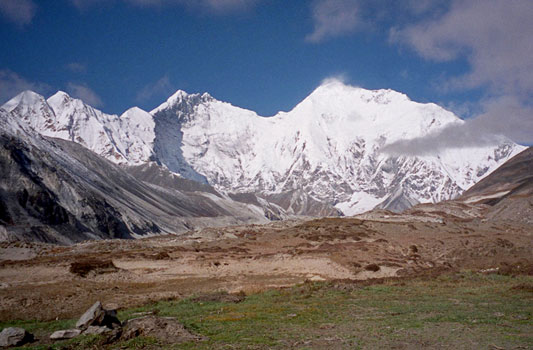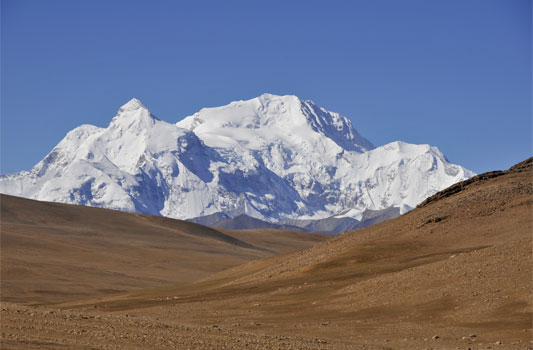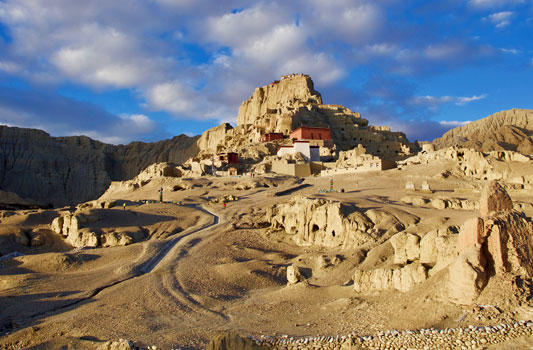What our guest are saying
Starting From $.00 per person
Happy Holidays Treks & Expedition offers special fixed trips to Mt. Kailash & Lake Manasorovar to facilitate pilgrims & foreign tourists. We are probably on the few outfits that provide Nepali Sherpa staff support for all of our treks in Tibet so as to ensure similar high quality trek services that exist in Nepal.
Mt. Kailash, at 6714 m also known as Tise, Kailasa & Kang Rinpoche (jewel of the Snows), has since time immemorial been celebrated in many eastern cosmologies as Mt. Meru, the axis mundi. And as the center of the physical & metaphysical universe, Mt. Meru is sacred to the Buddhist, Jains, the Hindu & the Bonpos. For the Hindus, the mountain represents the seat of Lord Shiva, for the Buddhists, a terrestrial projection of the cosmic mandala of Dhyani-Buddhas & Boddhisatvas….. The Wheel of Life: for the Bonpos, Kailash was the sacred nine storey Swastika Mountain, upon which the Bonpo founder Sherab alighted from heaven. Four of the great rivers of the Indian subcontinent originates from here: the Karnali, which feeds into the Ganges (south): the Indus (north); the Sutlez (west) & the Brahmaputra (Yarlung Tsangpo, east).
Day 01 : Drive Kathmandu to Nyalamu (3800m) – 165 Kms,8 hrs, O/N at Hotel Snow lion
Day 02 : Drive Nylam to Pegu Tso (4850m) -221 kms, 7-8 hrs, Camp
Day 03 : Drive Pegu Tso to Saga (4640m) 185 kms, 7-8 hrs. Camp
Day 04 : Drive Saga to Paryang (4540m) – 185 kms. 7-8 hrs, O/N at Camp
Day 05 : Drive Paryang to Manasarover (4700m) 250 Kms,6-7 hrs, O/N at Camp
Day 06 : Full day Excursion to Lake Manasarover, Camp
Day 07 : Drive upto Starting point of Kailash parikarma, Start trek to Dira Puk (4909m)
Day 08 : Continue Parikarma over Dolmala Pass (5650m) to Zuthul Puk 22 Kms, 7- 8 hrs, Camp
Day 09 : End Kailash Parikarma near Darchen (4700m) 14 kms, 3 – 4 hrs, O/N Guest House
Day 10 : Drive from Darchen to Paryang (4540m) 277 kms,7- 8 hrs, Camp
Day 11 : Drive From paryang to Saga (4840m) 185 kms, 8 hrs
Day 12 : Drive from Saga to pegu Tso (4850 m) 115 kms,6 -7 hrs, Camp
Day 13 : Drive from Pegu Tso to Nyalam (3220m) 21 kms,7-8 hrs
Day 14 : Drive from Nylam to kathmandu, 125 kms, 5-6 hrs
Accomodation on twin Sharing basis at guest houses & Two men tent during camping, Sherpa staff, freshly cooked full board vegetarian meals, Dining & Toilet tents, Japanese Landcruisers (4 WD) & Support trucks, English speaking Tibetan Guide, Monastery entrance fees, Oxygen, Basic first aid kit, kailash permit and Normal Tibet / China visa fee.
Travel insurance, emergency rescue charges, Extra cost in the event of landslides, expenses of personal nature, Tibet visa rush fee if applicable, personal clothing & accessories including sleeping bags.
Gongkhar Airport is the main gate way to Lhasa. Chamdo airport and Nyangchu airport also provide air access into Tibet but are not very reliable because of bad weather.
From/to Kathmandu: From July till September Air China has daily flight from/to Kathmandu. During the low season there is only one flight per week (December till February).Contact us at info@holidaynepaltrek.com for flight details and fares.
From/to Chengdu: There are 2 flights from Chengdu daily. This connection offers a better connection into Tibet as Chengdu is connected with many cities such as Seoul, Bangkok and Hong Kong. Other connections are proposed for near future.
By Train
The Qinghai-Tibet (Qingzang) Railway connects rest of the mainland with Lhasa. Operation of this railway started in 2006. The Journey from Beijing to Lhasa is 2 days/48 hours. Besides Beijing there is rail connection between Lhasa and cities like Xining, Lanzhou, Shanghai, Guangzhou, Chongqing and Chengdu.
By Road
There are 5 road routes common with tourist to enter into Lhasa, Tibet.
Contact us at info@holidaynepaltrek.com for more details about access into Tibet from different routes.
Adventure Mission Nepal always works for the comfort and satisfaction of the valuable clients. We assist you will all our knowledge and resources to make your trip into Tibet a life time journey. There are things you should know and pay attention before you start your trip to Tibet with us.
Travelling within Tibet can be done by trekking on foot or by jeeps that are arranged by AMN. There is a train service which started recently from Lhasa via Golmud to other cities of Tibet. You can also ride bikes into Tibet from Nepal or India with special permits. There are intercity flights between Tibet and China and within Tibet as well but many are seasonal.
Using SUV is the best way to travel because of the road conditions but small cars and vans can be used in good roads depending on the group size. If your group is very large we provide large buses. We suggest you to travel to Tibet and use SUV, 3-4 people on each for better experience.
Chinese Yuan or Renmibi (people’s money) is the money used in Tibet. You can exchange money at the Bank of China or it’s authorized when you are in Tibet. 1 USD is equivalent to approximately 6 RMB. It is better to have local money while travelling to Tibet as credit cards are accepted in very limited places.
Most of the big towns of Tibet such as Lhasa, Gyantse, Tsedang, and Shigatse have different options of accommodation ranging from budget hotels with basic facilities to 4 star luxury hotels. In small town and villages the hotels are basic and sometimes with just a kitchen and a dormitory style rooms with people having to share with other travel companions. Tibet is for adventure not for luxury, if you have this in mind you won’t be surprised to see the remote nature of Tibet.
Guides in Tibet are not very fluent in English but we try to find the best among them. If you are travelling as a big group or want to join a fixed departure trip you can have a tour leader from Nepal who is experienced about Tibet and its heritages and fluent in English or language of your choice (German, Spanish, French).
The one good thing about Chinese coming into Tibet is they brought some good descent restaurant otherwise in Tibet the food choice is limited to barley, meat (mutton or yak) and dairy products, with very few spices or vegetables. The Chinese ethnic group Hui has some restaurant in Tibet which are cleaner because the Hui people are Muslim and strictly follow the Halal food laws. You can figure them out with the Green Muslim flag sign. If you are camping we provide quality food prepared by our camping crew.
It is wise to take consult your guide regarding places where you can take photographs. Places such as airports, bridges and government establishments are areas where you might not be allowed to take pictures. You might get fined or even get your cameras seized if you are caught photographing restricted areas. Most of the temples and monasteries allow photography but some might ask for a fee for using Camera inside the premises. Tibetans are shy in nature so don’t like being photographed but taking permission might help.
Cell phone network coverage is getting wider in Tibet nowadays. Even the nomads can be seen riding motorbikes and carrying cell phones. You can get sim cards in many places around Lhasa and other big cities. Cyber café’s with telephone and internet services are available even in small towns and villages. WI-FI is common in big hotels only; the small ones might charge you for using this service.
All of Tibet is in High altitude zone more than 4000m from sea level. Most of the travelers suffer from mild symptoms. Some mild symptoms include headache, breathlessness, fever, a loss of appetite, unrest, stomach disorder but once you start getting acclimatized the symptoms will go away. Proper acclimatization is very important so you must spend few nights in the towns before going up in the high passes. Use of Diamox and check up by a physician is advised if you have any doubts. Contact our trekking specialist for queries about high altitude sickness at info@holidaynepaltrek.com.
Tibet has tipping culture and drivers and guides are happy to receive tips. You can tip as you wish and for restaurants you can tip 10% of your total bill amount.
AMN tries its best to operate trips smoothly and without any discomfort to our valuable guests but many things is not under our control and most of the things are controlled by the Chinese authority. Weather in Tibet is also not predictable. AMN and its partner agencies will not be responsible in change of travel programs due to Political reasons and weather conditions. AMN and its partner in Tibet will not be for cancellations because of sickness of the guest before arrival, no show or cancellation of Flight. We recommend you to have a comprehensive insurance which cover cancellation, rescue and other unseen incidents.
Tibet is free of caste system and sexual discrimination. Even the womens have the same right and in some cases are dominant than males in the society. Tibetans are friendly and help people in need so there are no special precautions to be taken but it is wise to be safe as personal experiences can be different.
We feel very proud for being able to provide a nice travelling experience of Tibet for senior travelers. The hotels, guides and drivers AMN uses are well aware of the need of senior travelers. By tradition Tibetans show great respect to their elders and with guests they are very careful and respectful. Medical attention and supply of medicine is easily available in places where we operate trips for senior citizens.
Tibet offers limited entertainment for children. Children travelers are always immediately accepted by local kids and their families and in the process make new friends advise to consult with pediatrician before planning a trip to Tibet, to avoid any altitude related sickness for your child.


